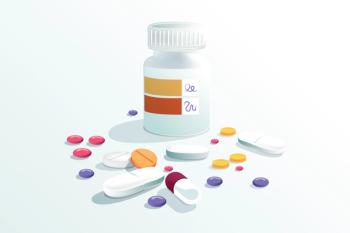
- MHE November 2021
- Volume 31
- Issue 11
Pipeline for Atopic Dermatitis is Full — and Full of Promise, but…
Safety concerns may limit JAK inhibitors as treatment for the common skin condition.
The research landscape for atopic dermatitis looks promising with several therapies in late-stage development. But safety issues have clouded one the future of one important class of drugs, and drug developers are hopeful that their products will be on the market soon.
And the market that they are eyeing is huge. Atopic dermatitis affects about 7% of adults in the United States. Of those affected, about 40% have moderate or severe symptoms that may need more advanced and expensive treatment.
Atopic dermatitis is a chronic inflammatory skin disorder that can cause intense, persistent itching. It is called atopic dermatitis because atopy is a genetic predisposition to develop allergies and dermatitis is inflammation of the skin. When skin is healthy, it tends to retain moisture and fend off bacteria and allergens. In people with atopic dermatitis, the skin is less protective and therefore vulnerable to irritants and allergens. Sometimes atopic dermatitis is called atopic eczema, and atopic dermatitis and eczema are often used interchangeably, although strictly speaking, atopic dermatitis is one of many forms of eczema.
Topical treatments — emollients and moisturizers — help many patients. Phototherapy, which can reduce histamine production, is an option. But some patients don’t respond to these and other treatments.
“We’ve had very few new options available to offer patients. Now we have several new therapies pending approval in the United States that could transform the therapeutic landscape for a topic dermatitis,” says Jonathan Silverberg, M.D., Ph.D., associate professor of dermatology at George Washington University School of Medicine and Health Sciences.
The only systemic biologic therapy on the market for the disease is Dupixent (dupilumab), a monoclonal antibody that inhibits interleukin-4 (IL-4) and interleukin-13 (IL-13), cytokines that play a role in inflammation and the immune response. Developed by Regeneron and Sanofi, Dupixent is approved for three indications: moderate to severe atopic dermatitis in people 6 years and older, as an add-on maintenance therapy for moderate to severe asthma in people 12 years and older, and as an add-on therapy in adult patients with chronic rhinosinusitis with nasal polyps.
Other monoclonal antibodies that inhibit IL-13 are in development. Results of phase 3 clinical trial of Eli Lilly’s lebrikizumab showed that it improves skin clearance and itch. In August 2021, Lilly released interim results of two trials that are evaluating lebrikizumab as a monotherapy in adult and adolescent patients with moderate to severe atopic dermatitis. Lebrikizumab also achieved key secondary end points versus placebo in patients with atopic dermatitis, including early onset in skin clearance and itch relief, improvement in interference of itch on sleep and quality of life. “The top-line results line results look quite impressive in terms of improvements of both skin clearance and improvements of quality of life, including itching and other symptoms,” says Silverberg, who is also a principal investigator for one of the lebrikizumab trials.
The full results from the two lebrikizumab trials will be released in 2022, officials from Lilly said. Data from a different phase 3 trial of the combination lebrikizumab with topical corticosteroids in patients with atopic dermatitis will by the end of 2021.
Another monoclonal antibody that targets IL-13 is Leo Pharma’s Adtralza (tralokinumab), which received approval in Europe in June 2021 for the treatment of adult patients with moderate to severe atopic dermatitis. This approval was based on three phase 3 trials that included 1,900 patients and demonstrated significant improvements in signs and symptoms, with treatment response rates gradually improved and maintained over time. But FDA issued a complete response letter — essentially a nonapproval — for Adtralza in April 2021 and requested additional data related to the device component of the therapy. “The response letter was not related to the drug itself,” Silverberg says. “The FDA requested technical information about the syringe that is used. This seems like a unique situation that probably is not relevant or generalizable to the class.”
Five JAK inhibitors
The pipeline of atopic dermatitis treatment also includes several drugs in the Janus kinas inhibitor class. Janus kinases (JAK) are signaling enzymes within cells that activate interleukin receptors, so inhibiting them has the effect of reducing interleukin activity and therefore inflammation. JAK inhibitors are seen a promising class of medication partly because inflammation is the root cause of so many conditions, and JAK inhibition is broadly anti-inflammatory.
The FDA has approved a total of five JAK inhibitors: three for inflammatory conditions and two for blood disorders. The three approved for inflammatory conditions are Pfizer’s Xeljanz (tofacitinib), Eli Lilly’s Olumiant (baricitinib) and AbbVie’s Rinvoq (upadacitinib). Xeljanz has bee approved for rheumatoid arthritis and several other conditions; Olumiant and Rinvoq, for rheumatoid arthritis. The agency has also issued an emergency use authorization for Olumiant as treatment for hospitalized patients with COVID-19 and approved Opzelura (ruxolitinib), a topical formation of a JAK inhibitor, as a treatment for atopic dermatitis. Incyte’s Jakafi (ruxolitinib) is approved to graft-versus-host disease in patients 12 years and older, as well as a type of blood cancer called polycythemia vera in adults. Celgene’s Inrebic (fedratinib) is approved as a treatment for myelofibrosis, a bone marrow disorder.
In January 2021, the JAK inhibitors hit a major bump in the road. A postmarketing cardiovascular safety trial of Xeljanz in patients with rheumatoid arthritis found there was a higher risk of cardiovascular adverse events in patients treated with Xeljanz. Pfizer’s study compared Xeljanz with a TNF inhibitor and included 4,362 patients. The primary analyses included 135 patients with major adverse cardiovascular events (MACE) and 164 subjects with malignancies (excluding nonmelanoma skin cancer). The most frequently reported MACE was myocardial infarction, and the most frequently reported malignancy was lung cancer. In those patients with a higher prevalence of known risk factors and malignancy — such as older age and smoking — a higher occurrence of events was seen across all treatment groups.
As a result, in September, the FDA started requiring the JAK inhibitors to carry a warning about the increased risk of serious heart-related events such as heart attack, stroke, cancer, blood clots and death. But the warning only applies to medications used to treat arthritis and inflammatory conditions. Jakafi and Inrebic are not subject to the warnings, agency officials said, because they are used to treat blood disorders and they require different updates.
Missed PDUFA dates
The findings have resulted in FDA officials looking more closely at safety issues of Xeljanz and other therapies in the JAK inhibitor class. Several JAK inhibitors with applications under review have missed their Prescription Drug User Fee Act (PDUFA) dates — a date by which the agency is supposed to make a decision on a drug’s application for approval — as the regulatory agency takes more time to review the class.
“From an efficacy standpoint, the JAK inhibitors look very promising and even appear to be more effective than Dupixent in head-to-head studies and in a meta-analysis, at least for some end points in certain time points,” Silverberg said. “But the FDA has given an indication of clear concerns around safety. We’re waiting to hear back about what the agency will do with respect to their approval in atopic dermatitis.”
Earlier this year, several companies announced the agency would miss the PDUFA dates for their JAK inhibitors that were under review as treatments for atopic dermatitis and other indications. Pfizer’s abrocitinib is one of the JAK inhibitors in a holding pattern. Results of a Pfizer-supported phase 3 trial of two different doses of abrocitinib reported in the March 25, 2021, issue of the New England Journal of Medicine showed that both improved symptoms.
The FDA is also reviewing AbbVie’s application for Rinvoq as a treatment for atopic dermatitis. European regulators approved Rinvoq for atopic dermatitis in August 2021. AbbVie announced in July that the application for treatment of atopic dermatitis would miss its PUDFA date. The company had previously announced that the application for Rinvoq as treatment for psoriatic arthritis and ankylosing spondylitis would also miss its PDUFA date.
News of the delays came as results of a favorable, AbbVie-supported head-to-head study were reported in the August 2021 issue of JAMA Dermatology. Of those treated with Rinvoq, 71% achieved Eczema Severity Index, a commonly used measure of treatment effect in atopic dermatitis, at week 16 compared with 61% of those treated with Dupixent. Additionally, Rinvoq demonstrated statistically significant greater efficacy across all ranked secondary endpoints compared to Dupixent through week 16, including early reduction in itch and rates of skin clearance improvement. The most common adverse events were acne for the Rinvoq group and conjunctivitis for the Dupixent group.
Olumiant also missed its PDUFA date. It is approved in more than 40 countries as a treatment for moderate-to-severe atopic dermatitis in adults.
Further back in the pipeline for atopic dermatitis is nemolizumab, a monoclonal antibody directed against IL-31 being developed by Galderma. IL-31 plays a role in directly stimulating sensory neurons related to itch and contributes to inflammation. Results from a phase 2 study show nemolizumab-treated patients experienced significant itch relief within 48 hours of treatment, which was sustained at week 16.
Denise Myshko is senior editor of Formulary Watch®, a website affiliated with Managed Healthcare Executive®.
Articles in this issue
about 4 years ago
Location, Location, Location. That Also Applies to Cancer Treatment.about 4 years ago
Seeing LDL Cholesterol in a New Lightabout 4 years ago
Improving Latino Healthabout 4 years ago
Why Doesn’t the FDA have a Permanent Commissioner?about 4 years ago
Investors Bet Big on Digital Healthabout 4 years ago
Federal Drug Price Negotiation is Popular — Even Among RepublicansNewsletter
Get the latest industry news, event updates, and more from Managed healthcare Executive.




















































